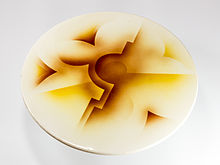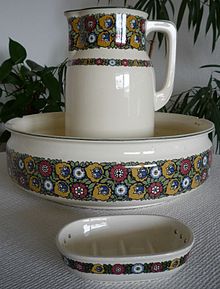Earthenware
Earthenware , invented in England in the 18th century, describes a group of ceramic products with porous shards , which can be further subdivided into the subgroups lime or soft stone , feldspar or hard stone and mixed stone ware .
Earthenware usually consists of clay , quartz , feldspar and possibly other minerals such as calcite . The products are usually molded using a casting process. The firing temperature of 970–1320 ° C is lower than that of sintered products . The color of the body varies from white to light reddish brown. Due to the low firing temperature, the body cannot sinter completely and, unlike stoneware, is not waterproof. That is why earthenware is usually provided with a glaze applied on all sides . It is transparent, often contains lead, and is melted in a second fire at temperatures around 100 ° C lower. The painting or the more frequent transfer decoration are applied to the dry body before the glaze firing. However, there are onglaze decoration techniques as well.
| Ceramics | Class: Earthenware | Sub-class: earthenware |
|
Properties and use
To this day, earthenware enjoys great demand and popularity, not only because of its inexpensive production, but also because of its properties similar to porcelain . However, earthenware is more sensitive to impact than porcelain and is not as pure white in the shards. It differs even more clearly from stoneware , with which it is very often confused linguistically because of the wording. But the material differences are clear: stoneware belongs to the class sintered ware , it is impermeable to water, has a darker, harder (light-sounding) body and is rarely as smooth and thinly glazed as earthenware. Only with products from more recent times are there problems of differentiation from porcelain stoneware due to similar decors and the same glazing techniques . Historic earthenware crockery is often unsightly because the crackling of the glaze caused by discoloration caused by fat and liquid. The main area of application for earthenware has been tableware since the beginning. Household goods were added in the 19th century: the indispensable washing dishes and all kinds of storage jars, bread boxes, etc. Specialized manufacturers have also been making wall tiles and decorative elements from this material since the end of the 19th century.
Cultural history of earthenware

The English model
In the potteries of Staffordshire an earthenware-like mass was developed in 1720 that a very bright on the basis of white clay and an addition of quartz powder production, hard and light, as thin moldable ceramic body allowed. The new technology gained supraregional and soon also effective importance beyond England when Josiah Wedgwood further developed this material, which was closer to porcelain, by adding kaolin . His company, founded in 1757, soon took on industrial characteristics. At the same time, he created a new stoneware style by following the change in taste of his contemporaries to classicism and by being inspired by ancient models.
Around 1765 he first produced creamware , a cream-colored earthenware. Its thin application of glaze made the delicacy of the relief stand out more clearly. The delivery of a dining service to Queen Charlotte also coined the term Queens-ware . Not quite correctly, the biscuit-like , unglazed and colored ceramic products, which are primarily associated with Wedgwood and are referred to as basalt ware and jasper ware, are often added to earthenware , which would be classified more correctly with "stoneware" or " soft porcelain ". Earthenware, with its new shapes and techniques, was soon being imitated in England and across the continent. The determination of the origin of individual items, often to be clearly determined using the dry or blind stamp , is often difficult for English export goods, as they were often not marked in order to facilitate trade past customs. This was mainly practiced during the continental blockade.
Earthenware in Germany
In 1775 the faience manufactory in Rendsburg switched to stoneware, around 25 other Germans followed by 1800. The continental barrier encouraged the development of an earthenware industry on the continent. Some of the goods were traditionally painted in faience style, but English creamware was most imitated. The decoration with transfer decors (England since 1755, France since around 1808, first documented in Germany in 1815) increased significantly in the 19th century, whereby the basic pattern of a combination of pictorial representations with decorative borders, developed in England and also used in other countries remains conspicuously constant. For more everyday dishes, stencils , stamping or spraying technology were also used. Since the mid-19th century (e.g. by Villeroy & Boch ), earthenware wall panels have been produced on a large scale and at a high artistic level . Waechtersbacher Keramik was one of the leading providers of sophisticated stoneware utensils in the first decades of the 20th century .
German and Austrian earthenware manufacturers and factories


The following selection lists the early German manufacturers that allow references (links) to relevant further articles. The following year numbers refer to the year of foundation or the conversion from faience to earthenware production.
- Althaldensleben, Nathusius porcelain factory , 1813, see also Nathusius Gewerbeanstalten Althaldensleben
- Annaburg , (1874-1883)
- Aschaffenburg, stoneware factory in Damm , from 1827
- Bonn, Poppelsdorfer porcelain and earthenware factory Ludwig Wessel , in place until 1969
- Frankfurt / Oder, Paetsch stoneware factory ,
- Biehla (Elsterwerda) , from 1900
- Bremen-Grohn, North German stoneware , 1869
- Bremen-Farge, Witteburg stoneware factory , 1853 to 1958
- CH Carstens, Elmshorn, 1870 to 1925
- Gersweiler (1846 to 1901)
- Stoneware factory Grünstadt (1801 - 1980)
- Hubertusburg (Saxony), 1770
- Ludwigsburg , around 1780
- Meißen, Teichert-Werke , wall panels since 1891
- Mettlach , Vaudrevange : Villeroy & Boch (merged in 1836)
- Neulautern , 1850
- Ottweiler (Saarland), 1776-1800
- Ratingen, Keramag (sanitary ceramics), 1903
- Reichenbach (Cham district), 1841–1863
- Rheinsberg (Brandenburg), 1762
- Sandersdorf (Altmannstein) , 1831
- Schramberg majolica factory , 1820
- Tonindustrie Scheibbs , 1923
- Varel, Friesland Porcelain Factory (formerly Melitta), 1953
- Velten, Velten-Vordamm stoneware factory (see history of the pottery industry in Velten ), 1914–1931
- Waechtersbach ceramic , 1832
- Vienna, ( Joseph Hardtmuth ), “Wiener Steinut”, 1789
- Wilhelmsburg, ÖSPAG , 1865
- Wrisberg woods , end of the 18th century
Collections
- Musée national de Céramique - Sèvres (French earthenware)
- First German Tile Museum Boizenburg (shows earthenware tiles from 1880–1930)
- Maupas Castle (France)
- Johannisburg Castle , Aschaffenburg (Dammer stoneware)
- Ceramic Museum Lindenhof (Wächtersbach stoneware)
See also
- History of ceramics (on non-European earthenware)
- Emilian , siderolite , and ceracron , earthenware-like pottery
- Tankard (stoneware section)
literature
- Lexikon der Kunst , Vol. 4, Leipzig 1977, pp. 668–669.
- Gustav E. Pazaurek: Stoneware - Design and History , Stuttgart undated
- Wolf Mankowitz: Wedgwood , London 1966
- Michael Weisser: Art Nouveau tiles . Bremen 1978
- Gustav Weiß: Ceramic Lexicon , Berlin 1984 (on technology)
- Dieter Zühlsdorff: Ceramic brands lexicon. Porcelain and Ceramic Report 1885-1935. Europe (mainland) , Stuttgart 1994 (with company portraits and data on the respective manufacturers)
Web links
Individual evidence
- ↑ Johann Georg Theodor Graesse: guide for collectors of porcelain and pottery, stoneware, earthenware, etc .: complete directory of the so present on older and newer porcelain, faience, stoneware brands Umgearb. by E. Zimmermann. Last revision by Arthur u. Luise Behse. 22. unchang. Edition - Braunschweig: Klinkhardt & Biermann, 1967
- ^ Altertumsverein Grünstadt (ed.): 180 years of the Grünstadt stoneware factory . Verlag Emil Sommer, Grünstadt, 1985, p. 56 u. 57


